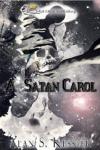A Satan Carol
Alan S. Kessler
Wild Child Publishing
$5.99 (Kindle)
Review by Darkeva
Horror readers tend to expect that any serious work of fiction involving Satan is going to be a violent bloodbath or an action-packed religious thriller. I certainly had that in mind for A Satan Carol by Alan S. Kessler, which deviates from the usual Devil fiction on the market. But readers of different genres have varied preferences of Satanic representations. A reader of Christian fiction will want something else compared to a reader of literary fiction, and the same applies to horror readers.
Nevertheless, Satan’s literary influence, particularly in genre fiction, continues to thrive with multiple releases a year devoted to the Devil. Many have argued that the Bible is one of the first, if not the first, horror stories known to man. The Devil is always an interesting character when done well, no matter what the medium, whether it’s Rosalinda Celentano’s astonishing turn as Satan in The Passion of the Christ and Viggo Mortensen’s striking interpretation in The Prophecy on the spectrum of great depictions to the downright bad, as with Gabriel Byrne’s unintentionally comedic performance in End of Days and the downright obvious with Tim Curry’s rather literal portrayal in 1985’s Legend .
Milton’s Paradise Lost portrayed Satan in a sympathetic light, going behind the reasons why he became what he did. Since then, modern scribes such as C.S. Lewis, Mikhail Bulgakov, and Neil Gaiman have continued the tradition of making Satan a fully fleshed out character, something that not all writers can pull off.
In Alan S. Kessler’s A Satan Carol, we first meet the Devil as Mr. Green in the backdrop of Ireland during the Great Famine. Green is an English landlord to poor Catholic Irish subjects like Meg, and routinely raises their rent without any notice to drive them out of their residences. Meg’s aim is to protect her son, Liam, who can heal the sick. Alas, miracle child though he may be, the Famine claims him.
We then make a somewhat shaky transition to the modern day in Massachussets where a teenage girl, Katie Katz, is about to have an abortion. Mr. Green becomes invested in the girl’s fate as he thinks that her unborn foetus is going to receive a “golden” soul with the power to heal and to see into the future, which he wants to intercept for his own son, Pal. He’s been screwing with Liam’s family through the ages, down to Orem, Katie’s grandfather, and right into the present.
Green tries to influence the events leading up to her getting pregnant as much as he can, but free will can only get him so far. He can’t force the people whose lives he’s screwing around with to go down his intended path, but he can try to steer them. Kessler switches between past and present timelines, veering into Orem’s Satanic childhood visitations to Fritz, a doctor who serves as one of Green’s most important tools, to Hugh Jackson, the man responsible for knocking up Katie Katz, daughter of Harvey, a lawyer who hires Hugh before he’s even finished college. Green is sneaky about influencing Hugh and continues to mess with his life under the guise of someone helpful. We also go into Harvey’s background, how he met and married Susan, a devout Christian, and his eventual fatherhood. In some ways, Harvey’s tale mirrors Hugh’s.
It doesn’t take long for all the pieces to come together for Green, and he becomes sure that he’s going to prevail and get the golden soul for Pal, but again, free will comes back to haunt him as the characters he so desperately tries to influence make decisions that start to screw up his plans. Although the ending ties up some loose ends, it leaves other things open for a possible continuation, as the characters we start out with become drastically different by the time things come full circle.
Kessler has laid the groundwork for an intriguing concept with some interesting aspects, particularly the idea of a “golden” soul that has existed for thousands of years and occupied such people of influence as Buddha and Genghis Khan, and it’s clear why Satan wants it. The author also makes an admirable attempt at highlighting a more multi-faceted Satan who is, in some ways, angry that the world no longer fears him, but ultimately, is the attention-seeking child, crying out for God to accept his wayward son, bitterly jealous of Jesus, only to have his hopes dashed, resolving to create his own universe outside of Hell. And although Green comes off as more believable when he’s subtle in his role as English landlord, his consistent soliloquies coupled with overly emphatic dialogue and sometimes cartoonish mannerisms made him a little too “in your face” for my taste.
Still, horror with religious overtones isn’t for everyone – indeed, readers who have different religious beliefs than those presented in A Satan Carol may not appreciate the author’s stance. However, as mentioned above, horror readers have different expectations of a story involving Satan. Christian fiction readers and those who have a penchant for a philosophical bent on Devil fiction will enjoy A Satan Carol.










Trackbacks/Pingbacks